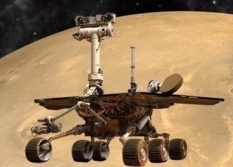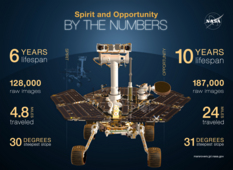A.J.S. Rayl • Jan 07, 2015
Mars Exploration Rovers Update: Opportunity Closes in on 11th Anniversary and We Look Back on 2014
Sols 3859 - 3888
With a wonder year of discoveries, historic feats, and bummers in the rear view mirror – and plenty of mettle to continue exploring – Opportunity ended 2014 quietly working in a temporary back-up mode, as her Mars Exploration Rover (MER) colleagues on Earth ramped up for the mission's marathon adventure to come in 2015.
The veteran robot field geologist has been studying different segments of the eroded western rim of Endeavour Crater since August 2011, when she pulled into Spirit Point at Cape York. The impact crater, located in Meridiani Planum, is huge, 22 kilometers (about 13.67 miles) wide and dates back to the Noachian Period some 4 billion years ago, a time when scientists believe Mars was warmer and more like Earth, with abundant water and erupting volcanoes. Roving from site to site along the rim, Opportunity has uncovered more and more evidence of past water that bolsters that theory.
Since leaving Cape York in May 2013, the robot has been on long journey south toward to Marathon Valley, the mission's next major science site. That's where, according to orbital data, a "mother lode" of clay minerals, and more evidence of past water, are waiting to be found.
In 2014, Opportunity roved from Murray Ridge to a point near the summit of Cape Tribulation, putting a total of 2,766.00 meters (2.76 kilometers / ~1.719.00 miles) on her rocker bogie. Along the way, the rover crossed her 40th kilometer and 25th mile and claimed the distance record for a robot on another planet. It was a long-awaited moment and an epic achievement.
The rover also made history when she captured Comet Sliding Spring in a set of landmark images, the first comet pictures ever taken by a robot on Mars or any planet other than Earth for that matter. And she returned breathtaking panoramas from emotional christenings in honor of colleagues lost. "Wdowiak Ridge was a big deal for us, and Pillinger Point was huge too," said Steve Squyres, MER principal investigator, of Cornell University. "Those milestones matter a lot."
Although no discovery in 2014 was particularly Mars-shattering so to speak, Opportunity did plenty of yeoman's work, sleuthing the bedrock, fractures, veins, and terrain to uncover solid evidence of aqueous alteration. The year's newfound data enriched the story of water at Meridiani Planum, adding a respectable chapter of evidence to support the theory that aqueous processes were at work for a long, long time in Endeavour's neighborhood – "what it's all about," said Ray Arvidson, MER deputy principal investigator of Washington University St. Louis (WUSTL).
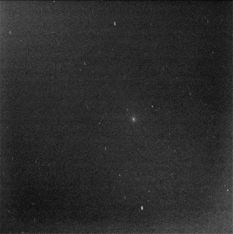
Comet Siding Spring
"Isn’t that cool?" said MER Principal Investigator (PI) Steve Squyres after Opportunity's historic images of comet C/2013 A1 Siding Spring streamed down to Earth. This two image blink shows a comparison of two exposure times in images the robot took with her panoramic camera (Pancam) as the comet flew near Mars on Oct. 19, 2014. The veteran rover took the images about two-and-a-half hours before the closest approach of the comet's nucleus to Mars when the sky was still relatively dark and before Martian twilight turned to dawn. The duration of the exposure resulted in a 2.5-pixel smear from rotation of Mars. It was the first time a robot on another planet "captured" a comet.NASA / JPL-Caltech / Cornell / ASU / TAMU
Most importantly, the MER mission earned its 9th mission extension, giving the rover and her team the green-light to continue the exploration of Endeavour's western rim, the first exploration ever of the rim of a large Martian crater, and the only ground expedition back to Noachian times for at least two more [Earth] years.
The end of 2014, however, proved to be challenging. The robot and her software team carried out a second reformat of her flash memory on December 4th, in an effort to eliminate or at least ease the increase in errors and sudden reboots she has been suffering since August.
The errors cause Opportunity to be unable to save her acquired data to flash, thus when she shuts down for the night she "forgets" it. And sudden reboots – not good for any system. The first reformat in September successfully resolved the rover's "amnesia" events and unwanted reboots for a couple weeks. But then the glitches returned, seemingly with a vengeance, and so the second reformat was scheduled.
For one sol, it looked like the second reformat worked. It didn't. The MER ops team took flash "offline" while engineers worked on a fix and the mission continued with Opportunity roving on in a back-up mode. Known as "crippled mode" in the MER lexicon, it can be a confusing term, because Opportunity is not crippled in any traditional sense of the definition.
Physically and in terms of mobility, this rover is roving well. "Crippled mode enables us to build a temporary file system in RAM and operate that way," said Squyres. "It is kind of a funny term, but that was the name it was given back in the early days of MER development. The rover is 'crippled' in the sense that any data products that it has acquired, it will 'forget' when it shuts down," he explained.
That's because RAM is volatile memory, quicker to access but power intensive, so it is designed to refresh with every reboot. Therefore, what Opportunity doesn't get downloaded gets – gone. Basically, crippled mode means the rover is operating with its volatile or RAM memory only.
Opportunity's flash memory is the non-volatile memory in her "brain," similar to our computer hard drives or that thumb-drive you got over the holidays. As long as the rover saves the data to flash, this memory drive stores that data after she shuts down for the night and indefinitely, until it can be downlinked to Earth. Ideal for long-term storage, flash is what has allowed the rover to acquire as much as 250 to 300 megabits of data in a given plan, store it, and download when the "pipeline" to Earth permitted, sometimes months later.
Considering that there are now five American missions operating at Mars, four orbiters and two rovers, the reality that the Deep Space Network (DSN) "pipeline" consists of three communications facilities located in California, Spain, and Australia, as it has for decades, and that demand for uplink and downlink time is heavy, it's obvious why the MER team wants Opportunity to maintain use of flash memory insofar as she can.
In addition to the flash issues, a lack of DSN uplinks and the holidays conspired "to limit what the rover was able to accomplish in December," said Bill Nelson, chief of MER engineering at the Jet Propulsion Laboratory (JPL) home to all NASA Mars rovers. Nevertheless, Opportunity trundled on toward the summit of Cape Tribulation.
During the second and third weeks of December, the robot logged four drives before coming to a rest for the year-end holidays. MER software engineers, meanwhile, were "diligently working on a flight software patch" to mask off the troublesome bank or sector of the flash memory, which, Nelson said, the team hoped to get through the required review not long after 2015 rings in.
Software starts and stalls aside, Opportunity made the best of 2014, true to her MER nature. "Old rover, new tricks, big records, more discoveries," summed up Arvidson. "It was a good year," agreed Squyres.
As 2014 turns to 2015, Opportunity is staring at the summit at Cape Tribulation from just 100 meters (328.08 feet) away. Once at the summit, the rover will have less than 600 meters to go to complete her marathon and what will likely turn out to have been an approximate 3.3-kilometer (about 2.05-mile) trek from Cape York.
"The exploration of Marathon Valley was the principal focus of our extended mission proposal," said Squyres. "We've been working hard to get there and preserving a lot of time in our timeline to do a lot of exploration there. We're hoping for more clays. That's what the orbital data tell us."
Better still, there's reason to believe that Opportunity may find more of the most ancient Martian strata ever uncovered on the Red Planet, Matijevic Formation as it's called. The rover first uncovered this ancient layer on Matijevic Hill in "one of the most important science campaigns on the whole mission," as Squyres defined it. "We're looking forward to that," he said on New Year's Eve. "The story of 2015, I hope and expect, is largely going to be about Marathon Valley."
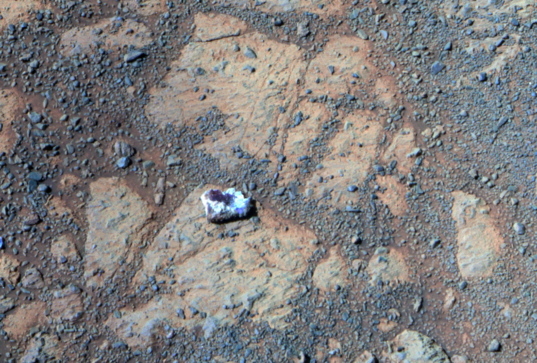
NASA / JPL-Caltech / Cornell / ASU
A Martian "jelly doughnut"
The sudden appearance of a rock about the size of an all-American doughnut or "Danish," as one of the JPL engineers clarified, surprised the MER team in January 2014. Primarily bright-toned, nearly white, Pinnacle Island's middle is deep red in color. Turns out one of the rover's wheels struck, broke the rock and tiddlywinked it to this position. The rock flipped upside down on landing, enabling the scientists to see inside. It was rich in manganese and likely altered by a lot of near neutral water. Martianally speaking, the rover's timing was just about perfect as celebrations of the MER's 10th year of surface operations on Mars were beginning around the world.Looking back on 2014
When January 2014 rang in at Endeavour Crater, Opportunity woke up on her Sol 3533 on the edge of an outcrop called Cape Darby in Cook Haven, a gentle swale or valley just off Murray Ridge, where she was spending her sixth Martian winter. While "hopping" from one north facing slope to another to soak up as much of the winter sunlight as possible, the solar-powered rover found outcrop after outcrop of impact breccia hurled up and formed by whatever created Endeavour Crater some 4 billion years ago, but not much else.
Although Cook Haven turned out to be less-than-thrilling science site, it would turn out to be an incredible location for another reason. The hints of the good fortune to come blew over the rover on December 31, 2013 and January 1, 2014, clearing some of the thick layer dust off its arrays and giving the rover a boost in power to start the New Year.
While the MER mission technically celebrated its 10th year of surface operations on January 3rd, one decade to the day after Spirit bounced to a breathtaking landing in Gusev Crater, the celebrations in 2014 officially launched with a NASA press conference at the Smithsonian Institution's Air & Space Museum in Washington DC on January 7, 2014, followed with the opening of the museum exhibit "Spirit and Opportunity: 10 Years Roving Across Mars."
In 50 images selected by MER team members, along with story captions, the exhibit at the national museum tracked the major findings and achievements in the now-legendary story of Spirit and Opportunity, the two golf-cart-sized robots that against all odds bounced to unbelievable, perfect landings in January 2004...and roved on and on and on.
Timing is everything and no rover knows that better than Opportunity. Her robot aim, from the beginning it seems has always been to please. As the rover was heading toward the finish line of her 10th year and just a week before JPL's celebration at Caltech on January 16th, she threw her colleagues a Martian mystery – as if to underscore that, despite the 10 years of exploration, this mission is far from over.
The strange white rock with a deep red interior turned up in images of an area Opportunity had been about 10 sols before. "We saw this rock sitting where it hadn't been 12 sols before," Squyres said. "It looks kind of like a jelly doughnut – and it's unlike anything we've ever seen on Mars."
As the "jelly doughnut" rock, called Pinnacle Island, appeared in news media outlets around the world, interest in the MER mission rose again. Then on January 24th, the day Opportunity completed her 10th year of surface operations, the science team published a landmark paper in the journal Science, concluding that billions of years ago, an ancient wet environment that was milder, warmer, wetter, and older than any the rover had previously found could have offered a habitat for life to emerge.
In "Ancient Aqueous Environments at Endeavour Crater, Mars," Arvidson, Squyres and other MER scientists base their conclusions on the evidence of clay minerals, in the form of iron-rich smectite and a more aluminous smectite that Opportunity ground-truthed at Matijevic Hill. They suggest the wet conditions that produced these smectites preceded the formation of the Endeavor Crater about 4 billion years ago.
On January 25th, Opportunity and her team put the 10th anniversary on their ever-increasing list of accomplishments, and went about solving the "jelly doughnut" mystery.
In February, the MER team discovered the rover had actually broken Pinnacle Island off a chunk of rock during a maneuver in late December 2013. "If you're a geologist out in the field, you carry a hammer to break up rocks and get at the un-weathered surface, because that's how you can identify the minerals," said Matt Golombek, MER project scientist at JPL. "At Pinnacle Island, by accident, we had a broken-off surface, which is incredibly illuminating to geologists."
From the concentration of the minerals found in Pinnacle Island, the MER scientists concluded it was a "water-processed rock," Golombek said. Opportunity checked out several other rocks next to Pinnacle Island's original location, looking at one, Stuart Island, up close. It too contained minerals indicating the past presence of near-neutral water. Still, Cook Haven was a haven of breccias. No surprises or ancient Martian bedrock would be uncovered there.
With the Martian wind beneath her winglets, the rover cruised through the depths of winter. Just five sols after the winter solstice on February 14th Opportunity woke up by Sun power alone, something it had never before been able to do during the bottom of a Martian winter. "We’ve never seen anything like this before," said Nelson. "Normally it takes months after winter to get a solar array wake-up."
Wind kicking up from Endeavour continued to swirl up slope in the rover's winter haven and then back down, dancing around the rover's arrays throughout February, enabling Opportunity to take in more sunlight power for energy. Cook Haven turned out to be the best "scour zone," as Arvidson described it, the rover had ever experienced, and despite the lack of exciting science targets, no one complained.
"We're looking toward celebrating the next 10 years now," John Callas, MER project manager at JPL, said then.
In March, the winds continued to steadily whisk more dust from the rover's solar arrays and Opportunty's power production jumped to 86% performance, as her energy level rocketed 150 watt-hours to 642 watt-hours. "This is the highest level we've had in winter since the first winter on Mars," Callas reported.
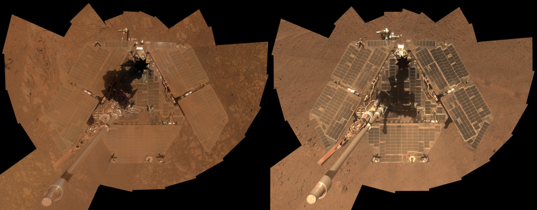
NASA / JPL-Caltech / Cornell / ASU
A Martian winter dusting
Opportunity took a self-portrait in January 2014, left, and then another in late March 2014 after it received a major "dusting" in the first quarter of 2014, shown on the right. As winds from the crater blew up and around Cook Haven, the rover's winter site on the western rim of Endeavour Crater, they cleared most of the accumulated dust from the solar arrays. The rover went from generating less than 375 watt-hours per sol in January 2014 to more than 650 watt-hours per sol in April 2014, about 2/3 of her maximum power production capability. Both images are presented as vertical projections in approximate true color and were compiled from pictures the rover took with her panoramic camera (Pancam). The mast on which the Pancam is mounted does not appear in the image, but its shadow does.On Earth, Opportunity was still a force with which to be reckoned and drew capacity audiences at the 45th annual Lunar & Planetary Science Conference (LPSC), held in The Woodlands, Texas. Among the presentations: Steve Ruff, of Arizona State University, dared to "use the 'L' word" to hypothesize that Gusev Crater, Spirit's greater stomping ground, really was once a lake back during the Noachian Period, while Arvidson, Ben C. Clark, of the Space Science Institute in Boulder, and Doug Mittlefehldt, of the Johnson Space Center presented the robot's recently-found evidence for aqueous alteration, and Larry Crumpler focused on describing the crater rim.
At the same time however, MER officials were confronting Opportunity's greatest potential threat: being cut from NASA's planetary science budget. Every two years, all extended planetary missions must present a proposal to continue and pass a Senior Review. The MER mission needed around $14.5 million dollars annually for full-time ops for the next two Earth years, according to one inside source.
However, in a table that was just released along with NASA's Fiscal 2015 Planetary Sciences budget, Opportunity and the Lunar Reconnaissance Orbiter (LRO) were zeroed out in 2015. That concerned more than a few LPSC attendees.
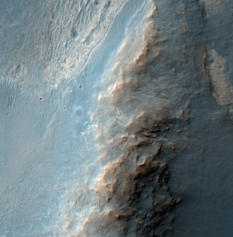
Valentine from Murray Ridge
Look closely at the center of this image and you will see Opportunity, a dot but a real dot, at work on Valentine's Day on Murray Ridge, part of the western rim of the ancient Endeavour Crater. This image from the High Resolution Imaging Science Experiment (HiRISE) camera onboard the Mars Reconnaissance Orbiter (MRO) was taken to check the remote possibility that a fresh impact by an object from space might have excavated a crater near Opportunity and thrown a rock, dubbed Pinnacle Island, the Martian "jelly doughnut" rock, into a spot where it hadn't been 12 sols earlier. No fresh impact site is seen in the image. Click to enlarge: The red arrow points to Opportunity at the center of the image. Blue arrows point to tracks she left since it entering the area seen here in October 2013, which is about 400 meters (about 1/4 mile) wide. North is toward the top.NASA / JPL-Caltech / UA
"If LRO is on top or Opportunity is on top, they will be funded," assured NASA's Planetary Science Division Director Jim Green, noting that a $56-billion-dollar proposed fund, the President's Opportunity, Growth and Security Initiative, would help fill financial gaps. This initiative, "fully paid for with a balanced package of reforms," according to official documents, was to be used for "investments in education; research and innovation; infrastructure and jobs; opportunity and mobility; public health, safety, and security."
Nevertheless, "the fact that Opportunity was explicitly [zeroed out] is serious," said Arvidson. "It means we have to re-double our efforts to produce an outstanding extended mission proposal."
Opportunity roved out of Cook Haven in April, clean as the proverbial whistle, and continued the journey south along Endeavour Crater's western rim. The rover followed Murray Ridge toward the next set of outcrops harboring clay minerals, more evidence of ancient water and habitable environments. Another software glitch put her into a safe mode for a couple of sols or Martian days, and a right front wheel motor drew slightly higher currents than normal for most of the month, but the intrepid rover drove on.
During her trek April, the Mars veteran chalked up her 39th kilometer, put a total of nearly 500 meters (about 0.31 mile) on her odometer, and overcame every annoyance.
Meanwhile on Earth, MER officials submitted that necessary proposal for a 9th mission extension as the scientists analyzed the Pinnacle Island / Stuart Island data. "It took a while to figure out, but these rocks were turned up in a little trough that's probably a fracture, and we uncovered these sulfates kind of topped with manganese oxides," said Arvidson. Geologically speaking, "you have deposition by evaporation of the sulfates, and then along came a very strong oxidant, probably oxygen, which probably dissolved some of the outer part of the sulfate and replaced it with the manganese oxide," he explained. "That's pretty neat."
Opportunity roved into history in another distinctive way in April when a JPL team, led by Kris Capraro, who primarily creates navigation maps of the Martian surface for planning rover drive paths, used the robot's data from Block Island, which she found in mid-July 2009, and replicated the iron meteorite with a 3D printer on Earth. It is the first-ever, three-dimensional, life size, true facsimile of a meteorite on Mars, and, as it happens, the largest meteorite found on the Red Planet to date.
During the first days of May, Opportunity pulled into a 240-meter (787.40-foot) long, 30-to-40 meter (about 98-to-131-foot) wide area where orbital data indicated the presence of a specific class of clay mineral smectite. The robot field geologist got to work checking out the rocks, ripples, and veins, looking to characterize the geologic context of the clays the team had scientific reason to believe are there.
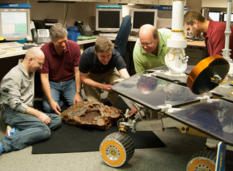
Recreating Mars meteorite
JPL researcher Kris Capraro added the finishing touches of realistic color to a model of the Block Island meteorite while team members look on. The real Block Island probably weighs about a half ton. The realistic model pictured above, which this team made from a 3D printer, you could carry under one arm.NASA / JPL-Caltech
The ancient clays weren't visible or obviously visible to human or rover eyes. However, the minerals that lit up data from the Compact Reconnaissance Imaging Spectrometer for Mars (CRISM) a visible-infrared spectrometer onboard the Mars Reconnaissance Orbiter searching for mineralogic signs of past and present water on the Red Planet, were the signature for montmorillonites, clays that feature aluminum-hydrated minerals.
"It's a very subtle signature, but it's real," Arvidson, also a co-investigator on CRISM, noted then.
Since montmorillonite forms when basalt is altered under wet and only slightly acidic conditions, at least on Earth, remnants of these clays would be a sure sign that water once flowed through these parts, perhaps even pooled here and there in ancient times. And finding evidence for past water is what so much of the MER mission has been about.
True to her MER determination, Opportunity purposefully passed through the area in a scientifically studious way. At the same time, the robot field geologist also took care of routine science and engineering housekeeping, which in May included beginning the process of slowly correcting the rover's spacecraft clock, which had drifted some 24 minutes ahead of real time, something that could cause the rover to misestimate its tilt or miss a communications window if not addressed.
As May came to an end, Opportunity had gathered a lot of data and dozens of images in what turned out to be a picturesque trek south along Murray Ridge, and back to a time billions of years ago. The montmorillonites, however, remained elusive and a bit of an enigma.
When June dawned at Endeavour Crater, the MER ops team found Opportunity in safe mode. The robot had experienced another unexpected reboot or warm reset on the second sol of a 'touch and go' on Sol 3680 (May 31, 2014). It was triggered, the MER engineers believed, by an error as the rover tried to write to her flash memory. The reboot was similar to warm resets that occurred in the past, and like the others, it seemed to occur because of a problem in Bank 7 of the rover's flash memory drive.
The rover had experienced these spontaneous and undesired flash write errors and reboots, for a few years, but very intermittently. In June, the writing was on the wall that these issues were no longer going to be so intermittent.
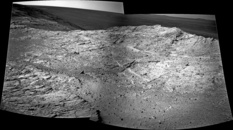
Montmorillonites in the matrix?
Opportunity hunted for montmorillonites (clay minerals) in May 2014, roving along this crest on Murray Ridge. The image shows a part of what was later joined with other images to create a large color panorama that would soon be named for a colleague from across the Pond. MER poet and planetary author and educator Stuart Atkinson processed this version.NASA / JPL-Caltech / Cornell / ASU / Stuart Atkinson
Opportunity pressed on, continuing the exploration of Murray Ridge at the western rim of Endeavour Crater. "We're driving, sort of hugging right along the peak of the ridge, because that's where a lot of the outcrop is," said Ashley Stroupe, one of the rover planners (RPs) at JPL.
The montmorillonites were nowhere, exactly, to be found. "I'm thinking now, they're everywhere," offered Arvidson. "I think the whole matrix is slightly altered."
On June 24th, a breathtaking view that Opportunity took with her Pancam back in May, at the northern end of the montmorillonite site, was officially released and the site christened in honor of Colin Pillinger, the British planetary scientist and professor who championed the U.K.'s Mars lander Beagle 2 in 2003. Pillinger passed away on May 7, 2014, in Cambridge, England at the age of 70.
The entire original MER team had been saddened by the news. The bond between MER and Beagle team members came naturally and ran deep, sharing as they did in a kind of against-all-odds, Martian camaraderie few other Earthlings know or could understand.
As June wound down, the dusty spring skies lightened a bit and Opportunity's power production rose back up to 745 watt-hours. "The rover is driving very well," said JPL's Paolo Bellutta, a MER rover planner. "I wish my car was lasting this long."
Behind the scenes word was circulating that after months of calculations, recalculations, and verifications, a Russian team, led by Irina Karachevtseva of the Moscow State University of Geodesy and Cartography (MIIGAiK), and a MER team, led by Brad Jolliff, of WUSTL, who is also on the Lunar Reconnaissance Orbiter Camera (LROC) team, were nearing consensus: the final revised distance for the Soviet Union's Lunokhod 2 on the Moon in 1973 was 39 kilometers (24.23 miles), one kilometer more than it had been for some 40 years. Technically, Opportunity surpassed Lunokhod 2's distance in April.

NASA / JPL-Caltech / Cornell / ASU
Pillinger Point Panorama
On June 24, 2014, the MER science team, which has scientists from many countries "onboard," officially announced that it christened the rocky ridge pictured here in honor of Colin Pillinger (1943-2014), in a NASA-JPL press release. Pillinger was the British principal investigator for the Beagle 2 lander that attempted to land on Mars just days before Spirit's bounce-down landing. Opportunity gazed down into the bowl of Endeavour Crater to take the images for this dramatic panorama of the site in mid-May, 2014. The vista spans from north-northwest, at the left, to south-southwest, at the right. The eastern rim of the crater is on the distant horizon. "I like to think Colin would have liked this view," said Steve Squyres, MER PI.In July, however, it became official: Opportunity logged her 40th kilometer on her Sol 3728. As fate or coincidence would have it, that was July 20th on Earth, 45 years to the day Apollo 11 put Neil Armstrong and Buzz Aldrin on the Moon and 38 years after Viking 1 lander touched down on the plains of Mars.
Seven days later, on July 27, 2014, the rover recorded her 25th mile and claimed the out-of-this-world distinction no one dreamed possible when the robot field geologist left Earth some 11 years before.
The longest-lived rover on another planet, Opportunity now claimed the distinction of also having traveled farther than any other vehicle too. "It's pretty darn wonderful," summed up Tim Parker, of JPL, who had been tracking and help charting Opportunity's path since the very beginning and helped provide an independent tally for the total distance of Opportunity's entire traverse since landing in Eagle Crater.
"There have been a lot of milestones during the course of this mission, but this to me feels like one of the more significant ones," reflected Squyres then. "What gives it significance for me is the history. Lunokhod 2 was just an incredible technical achievement for its day and that team set a record that stood for a very, very long time. It has been an honor to follow in their historical wheel tracks."
Never one to rest on her laurels, Opportunity took her new record and all the accolades – even the Tip of the Hat from Stephen Colbert – in stride and roved on, tallying a total of 698.71 meters (0.434 mile) in July.
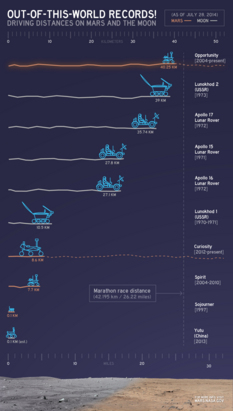
Opportunity sets record
Opportunity earned a new distinction in July 2014: the most-traveled vehicle on another planet. She was already the longest-lived. This chart shows a comparison of distances driven by various wheeled vehicles on the surface of Mars and Earth's Moon. Of the vehicles shown, Opportunity and Curiosity are still active and the total distances recorded are distances driven as of July 28, 2014.NASA / JPL-Caltech
As August dawned, Opportunity woke up at Cape Fairweather. After finding out it was be more recent Burns Formation, the rover continued driving south along the eastern edge of Endeavour Crater's western rim. "We've been hustling," said Arvidson.
Opportunity completed her science assignments during the first half of August, which included some touch 'n go's on targets of opportunity on the Bench. "We went down to the boundary area, investigated the Bench and confirmed it's the same kind of Grasberg materials as we have back around Cape York," said Arvidson. "Interestingly, that Bench material is very much depleted in manganese; whereas, we have a lot of manganese in the Endeavour rocks."
That would indicate either "a different provenance," that Grasberg came from a different region, not from Endeavour, or that water had moved through the Grasberg strata and "preferentially dissolved the manganese, bringing it up into the Endeavour rocks, the Shoemaker rocks," said Arvidson. "We are carrying those two hypotheses, and we're still looking at it."
Despite an increase in the occurrence of amnesia events and sudden reboots, Opportunity carried on, roving from the Bench back uphill to the northern side of Wdowiak Ridge. It had taken some time for the ridge to be christened. Wdowiak passed away on April 27, 2013. The team wanted his namesake to be something "really beautiful and memorable and befitting of the feelings we all had for Tom," said Squyres.
A beloved member of the original Athena Science team, and Wdowiak was a mentor to many planetary scientists and a professor of astronomy and astrophysics at the University of Alabama at Birmingham. "We saw this ridge from way off and I had a feeling, sort of identified this one in my head as a good candidate place," said Squyres.
The robot field geologist succeeded in making some measurements and considered taking the namesake panorama from that location on the northern end of the ridge. "But the reboots kind of put the kibosh on that," said Arvidson. Opportunity drove on, to the eastern side of Wdowiak Ridge, to get nearer to the small crater, Ulysses, cut into its southern end.
By mid-August, from her departure point at the southern end of Murray Ridge, Opportunity had driven half of the 2-kilometer (1.24 mile) trip to Marathon Valley. But a rapid and "curious" increase of reboots and sudden back-to-back events in the latter half of the month stopped the rover in her tracks and motivated the team to take prompt action. "We can't drive," said Callas. "We're resetting so frequently, we can't conduct a meaningful science mission."
The team commanded the rover, which had put a total of 410 meters (about 0.25 mile) in August, to hunker down and prepare for the process of reformatting its flash memory. Opportunity wound up spending the long four-day Labor Day holiday weekend American holiday downloading all the science and engineering data stored in her flash memory.
Other than the flash issue, Opportunity was in fine health. As August came to an end, the solar-powered rover was still producing upwards of 675 watt-hours of energy, even as the winds of Martian spring were sending more of the planet's ubiquitous, rusty red dust into the skies. "But the terrain is going to get rougher as soon as we get back into operations," cautioned Arvidson.
September would be another to remember for MER. On September 4th – the same sol Opportunity went through the process of reformatting her flash memory drive – NASA announced that it was granting MER its ninth mission extension, to begin later in the month. It was great news for the team, as well as all the people around the world who have followed the mission since the beginning.
The two-year extension means Opportunity will visit the new landscapes ahead at the summit of Cape Tribulation and Marathon Valley – and that one of the most remarkable and beloved planetary exploration missions of all time would have another two years to uncover more Martian history and perhaps make a little more history of its own.
Turned out, MER came in second to Cassini in the Senior Review's ranking of the planetary mission extension proposals, according to several sources. "We did pretty well," said Squyres. "We have a healthy rover, good weather, the funding we need, and terrific science ahead of us. It's continued good times for Opportunity."

NASA / JPL-Caltech / Cornell / ASU / S. Atkinson
Wdowiak Panorama
"When we saw this vantage point, we all went: 'Oh yeah, this is the place,'" said MER PI Steve Squyres. So Opportunity stopped in mid-September 2014 and took the images that compose the Wdowiak Panorama shown above, in honor of original MER Athena Science Team Member Tom Wdowiak, a beloved friend and mentor to many. "It's a beautiful view of Wdowiak Ridge from the south looking north, and beyond that you can see the Meridiani Plains, Murray Ridge, and into Endeavour," MER Deputy PI Ray Arvidson noted. "Wdowiak Ridge was a big deal for us," reflected MER PI Steve Squyres. "It's one of the milestones that really matter." Stuart Atkinson, author, MER poet, planetary science educator, and member of UMSF.com, "stitched" the rover's Pancam panels together and processed them into the Technicolor-inspired version presented here. For more of Atkinson's work, check out: The Road to Endeavour.From the eastern flank of Wdowiak Ridge, Opportunity kept on truckin' at Endeavour. Despite the successful reformat, the rover's flash-related issues returned as September progressed. But the robot almost seemed not to notice as she sent home two spectacular panoramas, including the traditional namesake panorama in honor of MER science team member Tom Wdowiak, from the southern end of the ridge. "This was a tough one," said Squyres. "We chose well."
Opportunity then headed to the small, relatively fresh crater, dubbed Ulysses that is dug into the southern end of the distinctive ridge. There, in the crater's ejecta field, the robot field geologist began checking out the intriguing, "somewhat different" and diverse collection of rock types hurled out from beneath by whatever created that small hole in Wdowiak Ridge.
During the final weekend of September, the rover bumped to position herself in front of Hoover, a dark grey rock in the ejecta mix that she would examine up close.
Although the skies were getting hazier with the springtime winds and Opportunity's power production had begun its seasonal drop, the rover was producing plenty enough power to set out on the "long haul," as Arvidson described it, to the next science waypoint, a summit in Cape Tribulation.
The MER team was starting to get a little anxious to get the rover to Marathon Valley. The scientists hope to find more Matijevic Formation there, the most ancient Noachian strata, the terrain there before Endeavour was created. The rover first set her stereo Pancam eyes on that ancient Noachian layer in a flat, light-toned rock called Whitewater Lake in August 2012, at the foot of Matijevic Hill at Cape York. But, she hadn't seen any Matijevic Formation since leaving Cape York.
The MER engineers also had their eyes on the next "prize." By the time Opportunity reaches Marathon Valley, the rover will effectively have completed the first marathon on another planet beyond Earth. Which is what inspired the destination's name. While always cognizant that science drives the MER mission, everyone seemed ready to have Opportunity get going.
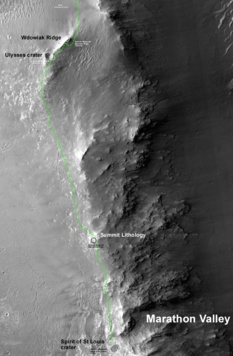
2014 rove route
This orbital image, taken by the Hi-RISE camera onboard MRO, shows a part of the eroded, western rim of Endeavour Crater. Charted in green is the Opportunity's route from around August 2014 and into 2015. At the end of 2014, the robot field geologist was just several hundred meters from the summit at Cape Tribulation, "Summit Lithology" on the map, and less than 700 meters from Marathon Valley, and from completing the first marathon on a planet beyond Earth.NASA / JPL-Caltech / UA / NMMNHS
The team had set the pace for the journey from Murray Ridge to Marathon Valley months before. The scientists wanted "at least 100 sols or more" to explore the area before the rover might have to settle in for winter on a north-facing slope. That, of course, will depend on her power production capability and the harshness of the season. "To maintain schedule, we should be pulling up to the Spirit of St. Louis Crater sometime in early 2015," said Arvidson.
But as September turned to October, several storms to the west of Endeavour converged and were spewing massive amounts of rust red dust upward, darkening the skies. Opportunity's power began to drop dramatically.
The storm wasn't exactly a big surprise. The Martian springtime is the season of dust storms and dust devils. Undaunted, the rover pressed on, studying more rocks in Ulysses' ejecta field throughout October, while the team kept watch on the storm.
Opportunity completed her assignments in Ulysses Crater's ejecta field in fine form, but what put her back in that headlines in October were her historic images of comet Siding Spring. Given the comet's close approach to Mars, the prospects of this rover being able to freeze-frame the iceball would be better than ever, but it was a photo op that was long in the planning.
During the previous year, a team of MER scientists led by Mark Lemmon, of Texas A&M University (TAMU), considered and calculated and crunched all the numbers and degrees. And together, with Opportunity, they achieved another first for MER. "It was a hard, hard observation, and I am very proud of the team for pulling this off," acknowledged Squyres.
The black and white pictures of Sliding Spring may not look like much in comparison to images of comets Halley and Hale-Bopp taken by professional astronomers from Earth, but no other robot has ever taken a picture of a comet from the surface of another planet. "These images show us what we would have seen if we had been there," said Lemmon. "It’s that knowledge that makes them such interesting pictures."
Although Opportunity continued to lose power through October, she was still producing approximately 1/3 her full power capability, plenty enough power to continue making tracks. Even so, the plan for the rover to hightail it away from Ulysses and Wdowiak Ridge and hit the road for some serious distance driving was tempered because of the storm's menacing presence. "Our pace was slowed down considerably because of the dust situation," said Squyres. "We are working our way away from the crater, but we're moving slowly – and we continue to monitor the storms very, very carefully."
Mars is infamous for its planet circling storms that from time to time completely enshroud the planet with the powdery stuff and there's no way of predicting when a regional storm will turn global. Although Opportunity survived a planet circling dust storm in June-July 2007, the MERs were not designed to withstand a Martian dust storm. Moreover, the rover doesn't necessarily have to be in the middle of a storm for its robot-life to be threatened.
The MER mission's lucky star was shining. The dust storm stayed well to the west of the rover and by month's end had begun to degrade or break apart and dissipate.
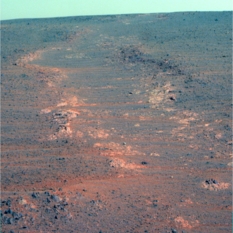
A fractured reality tale
Not long after resuming the journey south to Marathon Valley in early November 2014, Opportunity roved into a serious network of what looked to be fractures, hence natural conduits for water. The rover made a science stop right in the middle of the big fracture pictured above and checked out a vein. It turned out to be calcium sulfate "and probably gypsum," much like we think Homestake is, said MER PI Steve Squyres. The rover also examined surrounding bedrock. Details on its "curious" composition are still to come.NASA / JPL-Caltech / Cornell / ASU
The skies over Endeavour began to clear in November, and after nearly three months of collecting data, Opportunity finally departed Wdowiak Ridge-Ulysses Crater, maneuvering carefully through the rocky terrain, and getting back on the route south to the next science waypoint, a summit at Cape Tribulation. But after logging her 41st kilometer, the rover drove into a network of cracks that are likely fractures.
"This network of fractures lie both radially and concentrically to Endeavour Crater and are quite visible from orbit, and although they are not big chasms on the ground, they are very obvious features," said Squyres. The rover and her team had never seen such a network of fractures before on Mars.
Opportunity roved right into the largest fracture, which extends from the plains of Meridiani to the west into Endeavour Crater's rim, and worked there through the end of the month. "It's most likely a fracture that was generated by the impact, whatever created Endeavour," said Arvidson.
While many of these fractures were probably formed by the impact that created Endeavour during the Noachian Period on Mars and have been "reactivated," other cracks probably formed since Endeavour was created. "When one of these craters is formed, this big hole in the ground will then adjust itself gravitationally, [settling] in a process known as isostatic adjustment and during that process you can also have fracturing that takes place after the impact," explained Squyres.
No matter what happened at any point in the network, the fractures are potential evidence of past water flow and were worth checking out. That's because fractures serve as natural channels that "tend to carry fluids, which find the paths of least resistance," as Squyres put it.
Since the crack runs from the Meridiani Plains right into Endeavour's rim, it's an area where groundwater likely had been coming up to produce the calcium sulfate veins, and to slightly alter the local rock along the crack," proposed Arvidson.
Although the immediate hypothesis is that these fractures were most likely natural conduits for groundwater, the MER scientists are not discounting the possibility that surface water may have also flowed through these channels. "We're looking for both," said Arvidson. "This is still a work in progress, but whatever we uncover, it will add to the story we're writing about what happened here."
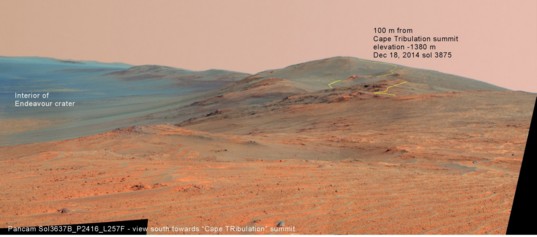
NASA / JPL-Caltech / Cornell / ASU / L. Crumpler
The route to Cape Tribulation
This panoramic image is a view south along the rim of Endeavour Crater. Cape Tribulation is centered on the highest part of the rim. Opportunity took this with her Pancam on Sol 3767 (Aug. 29, 2014) and it was processed in false color. Larry Crumpler, MER science team member and Research Curator at New Mexico Museum of Natural History & Science has shown the subsequent traverse of Opportunity as a yellow line in his blog. Note that the route "drops out of view" here and there as the rover is predicted to be negotiating valleys between ridges. As of end of Dec. 2014, Opportunity was about 100 meters from her destination on the top.Opportunity was slated to "button up" after the long Thanksgiving weekend, put the pedal to metal, and make serious tracks south as December dawned. But on Sol 3857 (November 29, 2014) the rover suffered another spontaneous reboot and though she recovered, it happened again on Sol 3858 (November 30, 2014). Like the amnesia events and the reboots in the weeks and months and years before, the Thanksgiving glitches seemed to come from the troublesome flash Bank 7.
The MER ops team was ready as the last month of 2014 began at Endeavour. Together, Opportunity and her software engineers reformatted her flash drive for a second time on December 4th. The rover got one good sol, but two sols later, the engineers took her flash out of use temporarily.
On Sol 3866 (December 8, 2014), the MER engineers cleared all the fault conditions and booted the rover into crippled mode, commanding Opportunity to store all newly acquired data and images in RAM. It changed the mission's procedure, requiring the team to download every sol's data before the rover shuts down for the night – at which point RAM data disappears, but it didn't phase the rover much at all.
Opportunity carried on, conducting light science activities on Sol 3867 (December 9, 2014), and then roving on in RAM mode on Sol 3868 (December 11, 2014), putting 42.49 meters (139.40 feet) behind her. She drove another 32.49 meters (106.59 feet) on Sol 3870 (December 13, 2014).
During the third week of December, she drove another 38.17 meters (about 125.23 feet) on Sol 3873 (December 16, 2014), and put an impressive 80.56 meters (260.30 feet) on her odometer on Sol 3875 (December 18, 2014).
With those drives, Opportunity racked up a total of 193.71 meters (~0.120 mile) in December and did just fine in crippled mode. She successfully took the usual drive direction images and atmospheric observations on the same sol of each drive and got them downlinked to Earth.
As December skated into the year-end holidays on Earth, Opportunity worked on light science assignments and finished another Earth year of Mars exploration without fanfare.
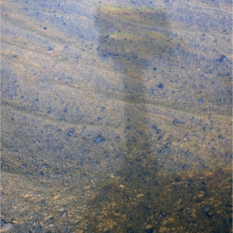
A shadow of 2014
Opportunity took this portrait of her own shadow on Dec. 10, 2014, her 3,867th sol or Martian day on Mars using her Pancam. The Pancam team processed it in false color, as shown above, which helps the scientists better distinguish different rocks and terrain features. And which makes for a more colorful image with which the MER Update closes 2014.NASA / JPL-Caltech / Cornell / ASU
Scientifically, 2014 turned out to be a year of increasing discoveries of aqueous alteration of the rim of Endeavour, "which is what it's all about," said Arvidson.
"The manganese findings in Pinnacle Island and Stuart Island and in the Endeavour [Shoemaker] rocks on the crater rim tell us about changing redox [reduction and oxidation] conditions on the surface of Mars, and dovetail very nicely with some manganese related findings made on the other side of the planet around the same time by Curiosity," added Squyres.
Indeed, Curiosity found veins filled manganese oxide deposits at Gale Crater, "again indicative of a very strong oxidant in the neighborhood, like oxygen," said Arvidson. The one notable difference is that Opportunity's samples contain sulfur; Curiosity's do not. "It all has to do because of the hydrology and geometry," he continued. "Opportunity is in an area that's lower area and we know that there's been upwelling groundwater that has been sulfur-charged in the past, the Burns Formation; whereas, in Gale, it's water that flows down. So it's not a lot of water being brought up. Rather it's water flowing and sinking into the interior of the crater."
As the MER Update was going to post, the results from Pinnacle Island and Stuart Island were in review at Nature Geoscience, along with a Curiosity manganese story. And Arvidson was already working on a summary of Opportunity's 2014 science findings for the LPSC in March 2015.
With 41,495.91 meters or 25.78 miles on her odometer, Opportunity shut down for the night and drew the curtain on 2014 on her Sol 3888. "It's been a year of mobility and discoveries and just pure exploration," said Squyres. "We have continued to conduct the first exploration-ever of the rim of a large Martian crater, seeing it in all its variability. We are making real progress over some pretty difficult terrain with a very old rover, towards what we think is going to be some fascinating science down the road."
Roving into 2015
The plans for Opportunity in 2015 remain the same: drive to the summit of Cape Tribulation, take what will probably be another breathtaking panorama from the vista point, and then rove on to Spirit of St. Louis Crater, and just beyond, Marathon Valley.
While New Year's revelers prepared for the ball to drop, the MER software engineers on Earth burned the midnight oil into the New Year on the workaround strategy to mask off the troubled Bank 7 of the flash drive, a "back pocket" strategy to be deployed in coming sols. Since the rover's flash drive is comprised of 8 banks, seven of which are dedicated to storing data Opportunity collects from the surface, the rover would lose 1/7th of its storage capacity, but, theoretically, this fix would allow the rover to continue using 6/7ths of the drive. "We're hopeful that this forthcoming reformat will fix most, but it probably won't fix all the flash problems," said Nelson. "But we hope that any further flash events will be rare and at the nuisance level for some years to come."
Until then – and no matter what – Opportunity has ably demonstrated that she can drive and work in crippled or RAM mode and still deliver the Martian goods.
During the course of the MER mission's near 11 years of surface operations, crippled mode has been a robot and mission saver. The use of crippled mode, for example, is what saved Spirit's mission back on Sol 18 when the rover experienced the infamous Sol 18 anomaly.
"Everything we need to do with this rover we can do in crippled mode if we need to," said Squyres. "We'd be fine. We would have to be more selective of what we do. If, for example, we have a 60-megabit downlink and take 160 megabits worth of images, we will get down 60 megabits and the other 100 are just going to evaporate."
Nevertheless, this team and this rover are up for any challenge and no planetary mission has succeeded in adapting and coming up with workarounds the way the MER team has. "We'd have to learn how to operate the vehicle all over again," admitted Squyres. "But we've done that a bunch of times. We had to learn how to drive all over again with a 5-wheeled vehicle when we lost the right front wheel on Spirit. We had to learn how to drive all over again when we lost the right front steering actuator on Opportunity. We had to learn how to do IDD work all over again when we lost the shoulder joint on Opportunity. We've faced this kind of thing a bunch of times and we've always found a way. And I'll tell you, driving in crippled mode is a lot easier than driving with five wheels."
The flash memory challenge that Opportunity is currently confronting has served in a weird way to energize the MER team even more.
"This flash issue is almost a little exhilarating," mused Squyres. "That may sound strange, because we don't want anything to go wrong with the vehicle, but at the same time to be continually presented with really new and different engineering challenges is stimulating. This is the kind of thing where we have to get creative. This is the kind of challenge that brings out the best in this team and it keeps things really interesting."
As the MER mission closes in on its 11th anniversary on January 24, 2015, the team and its rover promise to be raring to go, just like always. "We are immensely proud of our rover," said Nelson, speaking on behalf of all the JPL engineers that keep her roving. "Despite having problems with flash memory, Opportunity has overcome every obstacle so far and continues to diligently explore Mars, and we will continue to be behind her all the way."
When the rover reaches the Cape Tribulation summit in January 2015, she will be higher in elevation than ever before or ever will be again. And, she will only be some 600 meters away from completing the first-ever marathon on Mars.
"You don't want to bet against this rover," said Arvidson. "Opportunity just keeps coming through."
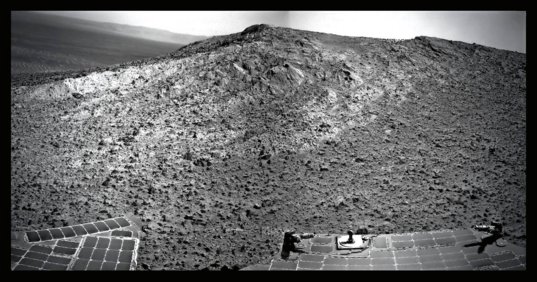
NASA / JPL-Caltech / Cornell / ASU / S. Atkinson
The summit just ahead
This was Opportunity's view of the summit at Cape Tribulation as December 2014 came to an end. The rover was about 100 meters (328.08 feet) from her destination. During the last week of the month and into the New Year's holiday, the veteran Mars rover took a series of images with her Pancam that Stuart Atkinson processed into the image we present here. For more of Atkinson's work, check out his: The Road to Endeavour.The Time is Now.
As a Planetary Defender, you’re part of our mission to decrease the risk of Earth being hit by an asteroid or comet.
Donate Today

 Explore Worlds
Explore Worlds Find Life
Find Life Defend Earth
Defend Earth


